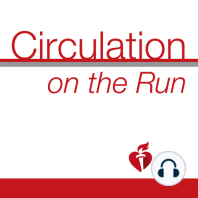18 min listen
Circulation December 11, 2018 issue
ratings:
Length:
24 minutes
Released:
Dec 10, 2018
Format:
Podcast episode
Description
Dr Carolyn Lam: Welcome to Circulation on the Run, your weekly podcast summary and backstage pass to the journal and its editors. I'm Dr Carolyn Lam, associate editor from the National Heart Center and Duke National University of Singapore. What are the long-term effects of oxygen therapy in patients with suspected acute myocardial infarction? Well, to find out, stay tuned for our discussion of our feature paper this week, coming right up after these summaries. The first two original papers demonstrate that, similar to neonatal mice, one day old and two-day old neonatal pigs are capable of mounting a cardiac regenerative response following myocardial infarction, which is characterized by restoration of contractile function, cardiomyocyte replenishment, and minimal fibrosis. Now, interestingly, this regenerative capacity is lost after the first two days of life. The first paper is from co-corresponding authors, Drs Yeh and Cook from National Heart Research Institute of Singapore and National Heart Center, Singapore, and the second from co-corresponding, authors Drs Zhang and Zhu from the University of Alabama at Birmingham. These authors report collectively that proliferation of preexisting cardiomyocytes appear to be the primary source of cardiomyocyte replenishment in neonatal pigs with markers of cardiomyocyte mitosis, sarcomere disassembly, and cytokinesis elevated following injury in the one day and two-day old hearts, but not at later time points. Furthermore, cardiomyocyte DNA synthesis was increased following neonatal pig myocardial infarction. Cardiomyocyte proliferation significantly decreased after this two-day window, which was associated with a marked reduction in telomerase activity. Heart failure with preserved ejection fraction may look different in the young compared to that in the elderly. First author, Dr Jasper Tromp, corresponding author, myself, Carolyn Lam from the National Heart Center, Singapore and Duke National University of Singapore, and our colleagues from the Asian Heart Failure Registry studied more than 1,200 patients with HEF PEF from 11 Asian regions and found that 37% of our Asian HEF PEF population was under 65 years of age. Younger age was associated with male preponderance, a higher prevalence of obesity, and less renal impairment, atrial fibrillation, and hypertension. Left ventricular filling pressures and the prevalence of left ventricular hypertrophy was similar in the very young of less than 55 years and elderly HEF PEF of more than 75 years of age. Compared to age matched controls from the community without heart failure, the very young HEF PEF patients had a three-fold higher death rate and twice the prevalence of left ventricular hypertrophy. Thus, young and very young patients with HEF PEF display similar adverse cardiac remodeling as their older counterparts, but very poor outcomes compared to controls without heart failure. Obesity may be a major driver of HEF PEF in a high proportion of HEF PEF in the young and very young. How important is hospitalization for heart failure as a complication of diabetes? In the next paper from first and corresponding author, Dr McAllister from University of Glasgow, the authors examined the incidents and case fatality of heart failure hospitalizations in the entire population age 30 years and older resident in Scotland during 2004 to 2013. Over the 10-year period of study, among 3.25 million people, the coot incidence rates of heart failure hospitalization were 2.4 per thousand-person years for tho
Released:
Dec 10, 2018
Format:
Podcast episode
Titles in the series (100)
Circulation March 21, 2017 Issue: Circulation Weekly: Your Weekly Summary & Backstage Pass To The Journal by Circulation on the Run
